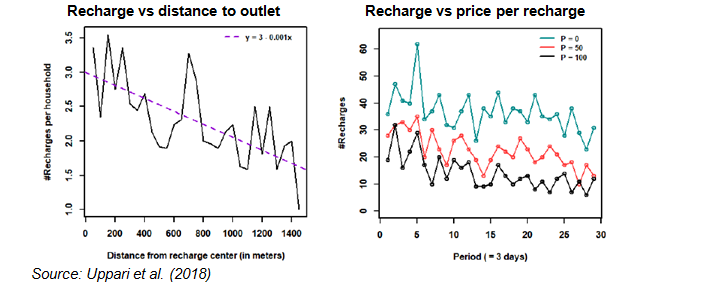
Lighting up Rwanda: Assessing the demand for pay-as-you-go lighting
The government of Rwanda has successfully increased the rate of electrification, from 10% in 2010 to 43% in 2018. However, for 57% of the population without electricity, the alternative energy sources include traditional biomass, kerosene, and rechargeable lamps which can harm respiratory health and the environment.
In 2017, the Rwandan government launched a universal electrification campaign, targeting 48% by off-grid and 52% by the main-grid. To reduce the fiscal burden of the programme, solar home systems have been designated for the lowest energy consumption segments, provided by the private sector. One obstacle to private sector involvement in electrification is affordability of off-grid systems for low-income households. Previous studies in Rwanda find that willingness to pay for solar devices is significantly low, requiring subsidies to encourage adoption (Barron et al. 2017, Grimm et al. 2016). Sustainable financial models for rural electrification are carefully being considered by both the public and private sector.
Pay-as-you-go financing as a solution
A research study funded by IGC Rwanda and Innovations for Poverty Action (IPA) looked at the extent to which pay-as-you-go financing can be adopted by households at the bottom of the energy pyramid (Uppari et al. 2018). Due to the dominant use of kerosene and traditional biomass in rural areas, competing modern energy solutions must offer customers affordable and flexible services in order to successfully penetrate the market (Uppari et al. 2018).
IGC Rwanda partnered with Nuru Energy to assess the drivers of adoption of its rechargeable LED lights. This in turn determines financial sustainability of the business. Nuru energy distributes and subsidises 8-WATT rechargeable lights to consumers. It finances this through revenue flows from recharge fees. Village-Level Entrepreneurs (VLEs) located within each village operate pedal-powered recharge services, priced to cover operations costs. Continued use of the devices requires at least one recharge every three days on average. For purposes of the study, each recharge device was fitted with a Global System of Mobile communications (GSM) to record and transmit real-time transaction data, linked with individual identification to a central database. This enabled the researchers to observe the actual usage of the lights in response to two randomised experiments:
- Recharge fees were randomly assigned to test the role of liquidity or cash-flow constraints towards usage of the lights.
- A reduced device capacity was randomly assigned to assess the role of role of inconvenience towards usage of the lights.
Rural households highly sensitive to small increases in price
The results plotted in Figure 1 below show that households’ uptake of rechargeable bulbs is hindered by usage fees and proximity to recharge outlets which is an indicator of inconvenience. Reducing the average distance to a recharge centre by 50% (or 300 metres) increases the number recharges by 45-50%. On the other hand, reducing the price-per-recharge by 50% (or 50 RWF) generates only a 17% increase. The latter result indicates that rural households are highly sensitive to small increases in the price of modern energy, but proximity to usage services is likely to play a greater role in sustained access to modern energy. Hence private firms in this market are likely to face low revenues, yet require substantial investments to improve proximity to their services. These findings suggest that for sustainable involvement of the private sector in Rwanda's off-grid electrification programme, policies which stimulate effective demand and improve connectivity can promote a viable private off-grid solar market, gradually reducing the strain on public resources.
Figure 1: Patterns of rechargeable light usage

Policy recommendations
- Invest in public goods to enhance the profitability of off-energy private energy firms.
Market failures and transport costs, especially prevalent in rural areas, affect profitability by raising costs and lowering potential revenues. This is the case for private firms in energy and other sectors of the economy. Investing in economy-wide public goods and also specific to the off-grid energy sector can improve the profitability of private energy firms, and reduce the fiscal expenditures on private subsidies.
- Economy-wide public goods: The majority of last-mile energy consumers reside in remote rural settlements with limited transport connectivity, and derive their income from agriculture. As a result, their capacity to afford off-grid connections is low, while logistics costs to supply them are high. This is amplified by their inability to borrow or hedge their income against climate risks. Addressing transport connectivity, and financial market failures could deepen rural markets and reduce the strain on public resources in support of private energy firms.
- Public goods specific to the off-grid energy sector: According to The Shell Foundation (2018), adoption of off-grid energy devices, and the viability of off-grid energy business by consequence, relies on customer knowledge and trust of the product. Trust is built through quality assurance as well as quality of service delivery, while knowledge is built through effective awareness campaigns. Consumers’ awareness and trust benefits the off-grid private business as a whole, while the cost to achieve them might prohibit individual firms from investing adequately. This necessitates public intervention to guarantee trust and awareness.
- Leverage remotely recorded off-grid energy usage data for informed decision-making. Private off-grid energy firms in developing countries increasingly use Global System for Mobile communications (GSM) to monitor and enforce payment remotely (The Shell Foundation 2018). If centrally compiled, this information could provide the government with a cost-efficient resource for decision-making. For example, the above study featured remotely collected bulb usage data. This could be used as an objective indicator of success in a results-based financing agreement with a private energy firm. The digital records created can also reduce information asymmetries between credit agencies, energy consumers and energy providers, resulting in increased access to credit for off-grid electrification.
References
Barron, M, R Philip, R Clarke and M Visser (2017), "A role for subsidies in the provision of renewable energy for the rural poor "
Grimm, M, L Lenz, J Peters and M Sievert (2016), "Demand for off-grid solar electricity: Experimental evidence from Rwanda (IZA DP No. 10427)", IZA discussion papers .
The Shell Foundation (2018), "Last mile solutions for low-income customers", Shell Foundation. https://shellfoundation.org/app/uploads/2018/10/Shell-Foundation_Last-Mile-Distribution-Report.pdf
Uppari, B, S Netessine, I Popescu, R Clarke and M Visser (2018), "Inconvenience, liquidity constraints, and the adoption of off-grid lighting solutions".

